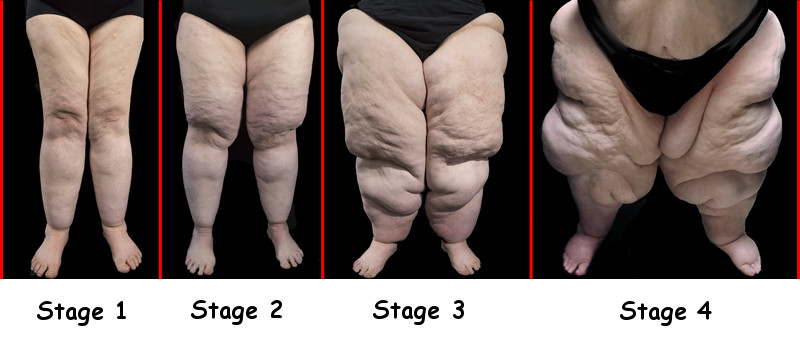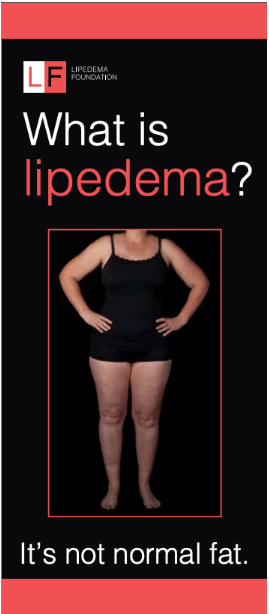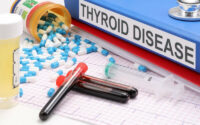June is National Lipedema Awareness Month
Lipedema (or Lipoedema as it is spelled in the European community) is a chronic progressive fat disease of connective tissue that affects more than 11% of women and less than 1% of men worldwide. This adipose connective tissue disorder is characterized by bilateral symmetrical swelling of the legs, thighs, hips and sometime upper arms. While the upper torso usually remains the normal size, the hips and thighs usually start enlarging disproportionately to the rest of the body. Clinicians and patients commonly confuse Lipedema with general obesity or even Lymphedema.
How can you help raise awareness for Lipedema this June? Educate yourself, your medical support team, join a support group, and spread the word about this rarely diagnose condition!

Lipedema is often called the “painful fat syndrome” as abnormal fat cells grow and cluster together and expand under the skin causing different sized nodules. Interstitial fluid increases between the clusters creating pain to touch, when walking and when standing. People in the later stages often complain about chronic pain when being touched where pockets of fat press on nerves. (Imagine the pain from a cat, dog or a small child crawling into your lap!) It can even seriously affect your mobility!
Signs and Symptoms of Lipedema

Since Lipedema can be a progressive disease it is important to diagnose early and start treatment right away! Does your or a family member’s body look like one of the four stages of Lipedema above? If so, please know this is a chronic disease, most likely hereditary, and is NOT YOUR FAULT! But, you can do something to help your condition and even reverse it back to a more manageable condition!
Do you recognize these symptoms:
- Lower body is disproportionate to your upper body
- Symmetrical appearance of affected limbs, but the feet are still normal
- Tenderness or pain in parts of you hip, thigh or leg areas (pea to fist size lipomas)
- Bruising happens easily (even if you didn’t bump into something)
- Upper arms may be affected (and would be symmetrical)
- Skin may be spongy at first then lumpy or bumpy
- Diet and exercise have no effect on your lower body
- Skin folds or pads may have appeared over or behind the knees or ankles
- Loose joints and ligaments (particularly in the knees)
- Swelling that when elevated does not provide relief (hot weather makes it worse)
- Hormonal changes make things worse (puberty, childbirth, menopause)
- Pant sizes keep going up, prefer to wear skirts instead
If so, make an appointment with your clinician soon to discuss diagnostic criteria and treatment plans! It’s never too late to make lifestyle changes to help treat your Lipedema condition! This includes making dietary changes, targeted exercises specifically beneficial to those with this condition and good self care.
If you are still not sure, go ahead and take a Lipedema quiz designed by Catherine Seo and her group at the Lipedema Project.
Lipedema Body Types
In addition to the traditional four stages of Lipedema there are also several body types, known as phenotypes. Some people have larger thighs and hips, but no ankle cuffs (cankles) while others may have thighs, lower legs, and ankle cuffs. Sometimes upper arms, lower arms and lower abdomen area are involved too. See the different Lipedema body types on the our Lipedema page.
I purchased a copy of the book “Lipedema – The Disease They Call Fat: A Clinician’s Overview” for my doctor for education and to keep on hand should he treat people like me in the future. Consider a copy for your doctor or you can refer them to a Clinician’s Guide to Lipedema developed by the Lipedema Project for a disease primer, how to diagnose it and recommended treatments. There are also additional website resources listed below.
Read more about Lipedema on this site. If you identify with Stage 4 (like me) also check information on Lymphedema too.
Remember, it’s never too late to get help and there is a whole community of people like you and me wanting to help you with your Lipedema and/or Lymphedema needs.
Help spread the word that June is National Lipedema Awareness Month and get people the knowledge they need to understand and treat this disease! While there is no cure, there are treatments to help maintain or improve the quality of your life.
To your improved health!
Resources:
Sites:
- Dr. Karen Herbst – http://www.lipomadoc.org/
- Lipedema Simplified – https://lipedema-simplified.org/
- Lipedema Project – lipedemaproject.org
- Fat Disorders – https://www.fatdisorders.org
- Lipedema Foundation – https://www.lipedema.org/
- Lipoedema Ladies – https://www.lipoedemaladies.com/ (UK)
- Lipedema – https://www.lipedema.net/
Blogs:
- More Than Fat – https://morethanfat.com
- Legs Like Mine – https://legslikemine.com/
- Born2lbFat – http://born2lbfat.com/
- The Well-Rounded Mama – https://wellroundedmama.blogspot.com/
- Lipedema Fitness – http://lipedemafitness.blogspot.com/
Social Media:
- Facebook – More Than Fat (public page)
- Facebook – Lipedema Warriors (closed group)
- Facebook – Lipedema & KETO Way of Eating (closed group)
- Facebook – The Lipedema Project USA
- Facebook – Talk Lipoedema (primarily UK based



![Compassion Focused and Energy Healing Therapies [Lipedema]](https://morethanfat.com/wp-content/uploads/2019/11/Mind_Therapy-200x125.jpg)
Good post!
Thank you!
Well done, sliding in right before July 1! Especially after your bout with cellulitis this past month. Best wishes for continued healing!
Thank you! Yes, my special gift for Lipedema Awareness Month was a visit from our arch nemesis – cellulitis! It only took four weeks of strong antibiotics, but I think I am finally healed – at least from the cellulitis infection. Now back to addressing my own Lipededma and Lymphedema challenges and making progress on that front!